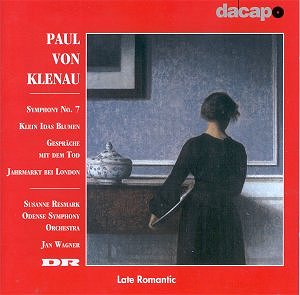Von Klenau's unreconstructed dives into dodecaphony
produced three twelve-tone operas. The last was premiered in occupied
Copenhagen in 1941. It was very well received. Strange to think that
similar works had been damned as 'entartete musik' elsewhere in the
extended Reich.
The Storm Symphony seems a suitable title for
a symphony written in 1941 although the composer (rather like RVW in
the case of his Fouth and Sixth Symphonies) denied any suggestion of
a link between the work and the times. The music stands somewhere between
bleak Beethovenian conflict and super-charged Wagnerian braggartry.
The music modestly embraces dissonance. This is not music of exuberance
- violence and threatening suspense would be more the order of Von Klenau's
day.
A drastic gear-change brings us face to face with the
1916 overture to Little Ida's Flowers. Here the music veers from
Tchaikovskian balletic delicacy to Straussian fancy. A charming confection.
From the same year as the overture comes the Gespräche
mit dem Tod in which six dramatic songs with orchestra proclaim
a Wagnerian confidence which is darkened by streams from Zemlinsky and
Schreker. The music has a grand operatic reach which may be related
to Berg's song Das Wein or to Mahler's Kindertotenlieder -
not that he sounds anything like Mahler.
Von Klenau, the Francophile impressionist, emerges
in the Hampstead Heath piece. This proceeds at a steady andante
with a boy alto singing during the first section about ‘rain, rain,
rain’. The composer travelled extensively during the 1920s and London
was one of his stopping-off points. This writing is similar to the music
of the Spanish composer Isasi who spent much time in Germany as well
as to the works of Bienstock (by repute) and Rudi Stephan though Von
Klenau's orchestral textures have greater transparency and Gallic translucency.
For many years it was thought that von Klenau's tally
of symphonies stopped with the Seventh. Very recently an eighth and
ninth were discovered in Vienna. Perhaps we will hear them in later
volumes in this series. I hope so.
This is the second volume in a series inaugurated by
Dacapo 8.224134. That first disc comprised symphonies 1 and 5 as well
as the tone poem Paolo und Francesca. I suspect that the block
of the first five symphonies will be rather romantic in the Wetz and
Huber line; certainly the First is said to be Brucknerian.
Rob Barnett
